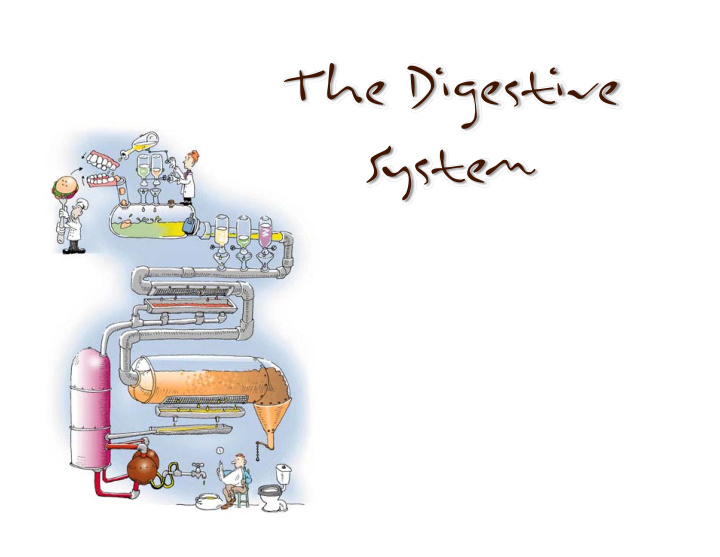



The Digestive System
Overview of the Digestive System • Organs are divided into two groups – The alimentary canal • Mouth, pharynx, and esophagus • Stomach, small intestine, and large intestine (colon) • Accessory digestive organs – Teeth and tongue – Gallbladder, salivary glands, liver, and pancreas
Overview of Digestive Processes 1. Motility 2. Digestion a. Mechanical b. Chemical 3. Absorption 4. Secretion
GI Tract Composition 1. Serosa Thin loose connective tissue, and epithelium which is continuous with the visceral peritoneum 2. Muscularis externa Responsible for motility in GI tract Longitudinal and circular muscles (exceptions in stomach and colon). Contains nerves (myenteric plexus) for local control 3. Submucosal Contains vessels, glands, nerves (submucosal plexus) 4. Mucosal Composed of three layers: a. Epithelium – highly variable depending on region b. Lamina propria, contains GALT (gut associated lymphatic tissue) c. Muscularis mucosae
GI Tract Layers
The Peritoneal Cavity and Peritoneum Peritoneum – a serous membrane Visceral peritoneum – surrounds digestive organs Parietal peritoneum – lines the body wall Peritoneal cavity – the thin sandwiched space between the visceral and parietal peritoneum.
Mesentery Structure • Mesentery – a double layer of peritoneum – Suspend & holds organs in place – Sites of fat storage – Provides a route for circulatory vessels Figure 22.5a and nerves
Mesenteries Superficial view of the abdominal organs Figure 22.6b
Mesenteries
Mesenteries • Greater omentum and transverse colon reflected • Visible Mesenteries: – Greater omentum – Transverse mesocolon – Mesentery – Sigmoid mesocolon Figure 22.6c
Mesenteries • Sagittal section through the abdominopelvic cavity • Visible Mesenteries: – Lesser omentum – Falciform ligament – Transverse mesocolon – Mesentery – Greater omentum Figure 22.26d
Organ Location with respect to the Peritoneum & Mesenteries • Retroperitoneal organs – Behind the peritoneum • Pancreas • Duodenum • Portions of colon • Peritoneal organs – Digestive organs that keep their mesentery Figure 22.5b
The Mouth and Associated Organs • The mouth – oral cavity – Mucosal layer composed of . . . • Stratified squamous epithelium • Lamina propria • The lips and cheeks – Formed from orbicularis oris and buccinator muscles, respectively • Site of start of chemical digestion! – Salivary amylase & lingual lipase
Anatomy of the Mouth Figure 22.8a
Anatomy of the Mouth • The labial frenulum anchors the tongue • The palate – forms the roof of the mouth • The palatoglossal arch and uvula form the fauces (the arches that open into the oropharynx) Figure 22.8b
The Tongue • Muscular structure of tongue: – Interlacing fascicles of skeletal muscle • Tongue functions: – Motility ‐ grips food and repositions it – Communication ‐ helps form some consonants – Taste • on the surface of the tongue and adjacent areas of the pharynx and larynx. • Taste buds lie at the sides of epithelial projections called papillae. There are three types of papillae: – Filiform – Fungiform – Circumvallate
Gustatory Receptors
The Teeth ‐ dentition and dental formula • Deciduous teeth – 20 teeth – First appear at 6 months of age • Permanent teeth – 32 teeth – Most erupt by the end of adolescence • Dental formula – shorthand – Way to indicate number and type of teeth. For Example: I 2/2, C 1/1, P 2/2, M 3/3), where I= incisors, C = canines, P = Premolars, M= Molar and the numbers represent the numbers of teeth in the upper and lower quadrant. To get the total number of teeth in a mouth, add all numbers and multiply by 2 = 32 teeth! • Functions in mastication!
The Teeth Permanent (Adult) Teeth Deciduous (Baby) Teeth Figure 22.10
Tooth Structure • Longitudinal section of tooth in alveolus Figure 22.11
The Salivary Glands • Produce saliva • Compound tubuloalveolar glands – Parotid, submandibular, and sublingual glands Figure 22.12
The Pharynx • Oropharynx and laryngopharynx – passages for air and food – Lined with stratified squamous epithelium – External muscle layer • Consists of superior, middle, and inferior pharyngeal constrictors – What about the nasopharynx?
The Esophagus Gross anatomy • – A 25 cm long simple muscular tube – Begins as a continuation of the pharynx at the upper esophageal sphincter – Travels through the posterior mediastinum – Joins the stomach inferior to the diaphragm – Ends at the lower esophageal sphincter (cardiac sphincter) Microscopic anatomy • – Epithelium is stratified squamous epithelium – When empty • mucosa and submucosa in longitudinal folds – Mucous glands • primarily compound tubuloalveolar glands – Muscularis externa • skeletal muscle first third of length, then smooth – Most external layer – adventitia
Esophagus Muscularis Mucosa Submucosa Note the thick stratified squamous epithelium as well as the submucosoal and muscularis layers.
The Stomach • Starts at the end of the esophagus (esophageal ‐ stomach junction)
The Stomach • Site where food is churned into chyme – Due to churning action created by the additional oblique muscle layer (in addition to the longitudinal and circular muscles) • Carbohydrate digestion continues until salivary amylase is denatured in acidic lumen • Protein digestion begins – Secretes pepsin – Functions under acidic conditions • Absorption limited – Water, alcohol, salts, aspirin
The Stomach • Capacity: ~ 1 qt. (slightly less than 1 liter) • Size: ~12 inches long, by 6 inches wide • Start: junction of esophagus • End: pyloric sphincter
The Stomach – Gross Anatomy Figure 22.14b
The Stomach Microscopic Anatomy Histology of Stomach
Recommend
More recommend